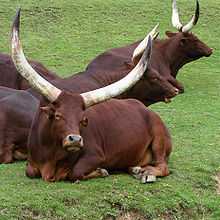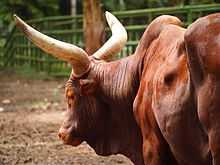Ankole-Watusi

The Ankole-Watusi, also known as Ankole longhorn,[1] is a breed of cattle originally native to Africa. Its large, distinctive horns, that can reach up to 8 feet (2.4 m) from tip to tip, are used for defense and cooling by blood vesseled honeycombs.[2] Ankole-Watusis weigh from 900 to 1,600 pounds (410 to 730 kg).
Living in the savannas and open grasslands, their diet consists of grass and leaves. The animal is sometimes known as Ankole or Watusi, and is a breed of Sanga cattle.
Characteristics
Ankoles are able to utilize poor quality forage and limited quantities of food and water. These survival abilities have allowed them as a breed to not only survive the centuries in Africa but to become established in Europe, South America, Australia, and North America.

The Ankole-Watusi is medium in size, with cows weighing 950–1,200 pounds (430–540 kg) and bulls weighing 1,200–1,600 pounds (540–730 kg). Newborn calves weigh just 30–50 pounds (14–23 kg) and remain small for several months. This low birth-weight makes Ankole-Watusi bulls useful for breeding to first-calf-heifers of other breeds.
During the day, the calves sleep together, with an "auntie" cow nearby for protection. At night, the herd-members sleep together, with the calves in the center of the group for protection. The horns of the adults serve as formidable weapons against any intruders.
History
Ancient rock paintings and depictions of Ankole-Watusi cows have been observed in the Sahara region and in the Egyptian arts and pyramid walls. There is a breed called the Sanga that spread to the Sudan, Uganda, Kenya, and other parts of eastern Africa, becoming the base stock of many of the indigenous African breeds. The Sanga demonstrated most of the typical Zebu characteristics, such as pendulous dewlap and sheath, upturned horns, and a neck hump of variable size. Modern descendants of the Sanga, however, vary greatly in size, conformation, and horns, due to differing selection pressures by different tribes.
Particularly remarkable are the cattle found in Uganda, Rwanda, and Burundi. In Uganda, the Nkole tribe's Sanga variety is known as the Ankole. In Rwanda and Burundi, the Tutsi tribe's Sanga variety is called the Watusi. The Rwanda common strain of Watusi is called Inkuku. The giant-horned strain, owned by the Tutsi kings and chiefs, is called the Inyambo, though some current tribal reports claim that this type is now extinct. Traditionally, Ankole-Watusi were considered sacred. They supplied milk to the owners, but were only rarely used for meat production, since an owner's wealth was counted in live animals.
Under traditional management for milk production, the Ankole cow is grazed all day, then brought home to her young calf. The calf is allowed to suckle briefly to stimulate milk letdown, then the cow is milked. The calf suckles further after hand-milking has finished and then is separated from its mother again. The process is repeated in the morning. This minimal nourishment of calves results in high death rates in the young. Milk production is not high, with a typical cow producing only 2 pints of milk daily for humans, although an exceptional one can manage up to 8 pints. In addition, the lactation period is short. Over the last 10 years, the national government has attempted to select for animals which produce more milk and have better meat production. Famine and disease, as well as the conflict with traditional practices, have slowed this effort.
Ankole-Watusi have played a pivotal role in the lives of various African tribes – Tutsi, Ankole, Bahima, Bashi, Bakiga, and the Kivu – although the Tutsi are most often associated with the breed. The cattle provided food, currency, and tribal status. In Rwanda, where the Tutsi ruled, Watusi were known as Insanga, "the ones which were found" and Inyambo, "the cows with long, long horns". Those with the largest and longest horns belonged to the king and were considered sacred, with some individuals having horns that measure 12 feet (3.7 m) from tip to tip. The breed is often referred to as the "Cattle of Kings".
Watusi first arrived in America in the 1960s when Walter Schultz imported two bulls from Scandinavia and a female from Europe. Thanks to the efforts of private breeders, zoos, and associations, this animal is no longer endangered. However, in his book 'Uganda: the land and its people' (ISBN 978-9987-9308-9-0), Mr. Godfrey Mwakikagile states that the breed's pure genetics are under heavy stress through cross-breeding with Holsteins insofar that the breed may disappear altogether locally. This was caused by the introduction of the highly milk-productive Holstein breed by the Heifer International program. These Holsteins need medical support and are susceptible to disease. The indigenous Ankole breed is fully adapted to the region's climatical conditions, their horns -often seen as ornaments- actually disperse heat.They are much more able to cope with adverse local conditions such as drought, while the Holsteins are consuming unsustainable amounts of dwindling resources.
Record
Two Ankole-Watusi individuals are in the Guinness World Records for the largest horn circumferences for a bull and steer, respectively. The bull, named CT Woodie, had horns which measured 40.75 inches (103.5 cm) around on September 20, 2004.[3] The steer, named Lurch, had horns measuring 37.5 inches (95 cm) around on May 6, 2003; he died on May 22, 2010.[4]
References
- ↑ Ankole, Breeds of Livestock
- ↑ http://ngm.nationalgeographic.com/2011/07/food-ark/cattle-breeds#/4
- ↑ "Largest horn circumference – bull". Guinness World Records. Retrieved February 14, 2012.
- ↑ "Largest horn circumference - steer". Guinness World Records. Retrieved February 14, 2012.
External links
| Wikimedia Commons has media related to Watusi cattle. |
- Ankole Watusi International Registry
- World Watusi Association
- Rice, Andrew (January 27, 2008), "A Dying Breed", The New York Times
- Animal Bytes
- Lurch, the bull with the largest horns in the world | Oddity Central – Collecting Oddities
- Lurch, the steer with the largest horns in the world, dies retrieved 20130127